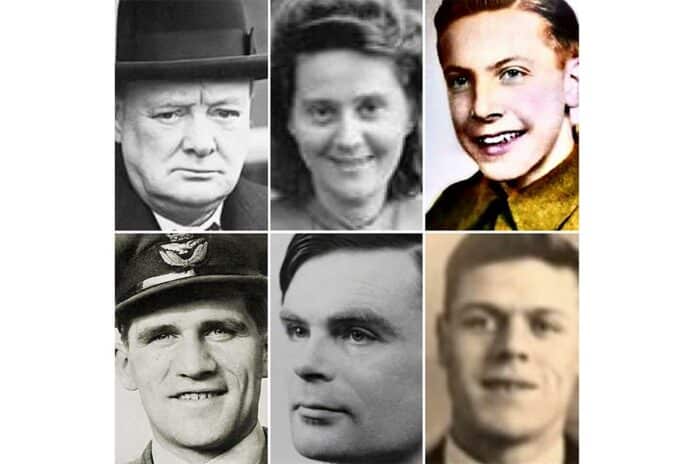Great Western Railway (GWR) is to name a train after Sir Winston Churchill as it marks 75 years since the end of World War Two and the declaration of peace in Europe.
The wartime leader is one of six remarkable individuals involved in the conflict to be commemorated by GWR as it salutes the Second World War generation.
At an earlier train naming ceremony in March, GWR honoured Odette Hallowes, a French citizen who lived in London and Devon/Somerset. Odette became a Special Operations Executive (SOE) and the most highly-decorated spy of the war.
Alongside Sir Winston Churchill, others who will have an Intercity Express Train named after them as part of our VE Day celebrations are Odette Hallowes, Harry Billinge MBE, Ken Rees, Alan Turing and Cpl George Sheard.
All six train naming ceremonies were to be held in the run-up to VE Day but have been postponed until a relaxation in the Government’s Covid-19 restrictions allow them to continue.
GWR Head of Communications Dan Panes said: “We at Great Western have a long history of naming trains after Great Westerners, the past and present heroes from across our network.
“It is right that we honour some of those heroes of the war effort, remembering the sacrifice, bravery and tenacity that later generations owe so much to.
“We will carry on with these naming ceremonies once it is safe to do so.”
Sir Winston Churchill
An inspirational statesman, writer, orator and leader who led Britain to victory in the Second World War. He served as Conservative Prime Minister twice – from 1940 to 1945 and from 1951 to 1955.
He was famous for his inspiring speeches, and for his refusal to give in, even when things were going badly.
Widely considered one of the 20th century’s most influential figures, Sir Winston was given a state funeral upon his death in 1965.
Odette Hallowes
Captured by the Gestapo in 1943 and interrogated 14 times, Odette convinced her captors she was related to Winston Churchill. Believing she could be useful, her life was spared. She was attached to the First Aid Nursing Yeomanry as cover for her secret work on behalf of SOE.
A train naming ceremony took place at Paddington station in March, attended by HRH The Princess Royal.
Commenting on the naming, her granddaughter Sophie Parker said: “I know she would be humbled by this and would want it seen as a tribute to all those brave women of the Special Operations Executive, especially those who never returned home.”
Royal Engineer Commando Harry Billinge MBE
A veteran of D-Day, Harry was 18 when he landed in the first wave at Gold Beach in 1944. He was a sapper attached to the 44 Royal Engineer Commandos and went on to fight in Caen and the Falaise Pocket in Normandy.
Harry was awarded an MBE in the 2019 New Year Honours List for his fundraising efforts in St Austell for the Normandy Memorial.
MP Johnny Mercer, Minister for Defence People and Veterans, said: “Harry’s an inspiration and a daily reminder of that incredible generation. We can never say thank you enough for the privileges and freedom we enjoy today because of your sacrifices 75 years ago.”
Wing Commander Ken Rees
A pilot with Bomber Command, Ken was shot down over Norway in October 1942 just two weeks after getting married. He was taken to Stalag Luft III, a prisoner camp designed for captured airmen and the scene of the Great Escape.
Ken was a digger on the Tunnel ‘Harry’, the longest of all the tunnels and the one used in the escape. In the film of the famous mission, Steve McQueen’s character is said to be based on Ken Rees due to his antagonistic attitude towards his captors, a result of his brother-in-law, Sqn Ldr Harold Starr, being shot.
Rt Hon Mark Drakesford SM, First Minister of Wales said: “It’s only fitting that Ken’s memory and the memory of other veterans is honoured, and what better way to do that than to name a train in their honour. I would like to thank them all for their service.”
Alan Turing
Alan was a key part of the Government Code and Cypher School at Bletchley Park which led the task of cracking codes used by German forces.
He famously led Hut 8, the section responsible for German naval cryptanalysis. He devised techniques for speeding up the breaking of German ciphers, including improvements to the pre-war Polish bombe method, an electromechanical machine that could find settings for the Enigma machine.
Alan’s name will be featured on GWR’s #trainbow train, 800008, reflecting his status as one of Britain’s most high-profile victims of homophobia.
Chris Heaton-Harris, Minister of State for Transport, said: “Alan died unrecognised, but his life has shaped our world. We see his legacy when we switch on a computer, we see it when we use our mobile phones. But most importantly, we see Alan Turing’s life reflected in our free and democratic society.”
Cpl George Sheard
A casualty of World War Two, George was one of the ‘Cockleshell Heroes’ – a group of young Royal Marines who volunteered for hazardous service to travel by kayak up the River Gironde from the Bay of Biscay to plant limpet mines on enemy ships in Bordeaux Harbour.
Of the 10 men who went on the mission, only two survived, six were executed and two drowned – one of them being George Sheard, 27.
Major General Matt Holmes CBE, Commandant General Royal Marines, said: “It’s a great honour that GWR has decided to name a train after Cpl George Sheard for his sacrifice and for us to enjoy the freedoms of travel in memory of his service.”
Videos of the six to have trains named in their honour can be viewed on the Great Western Railway Facebook page @gwruk and on Twitter @GWRHelp.
Photo credit: GWR







































 0113 2082620
0113 2082620 info@railbusinessdaily.com
info@railbusinessdaily.com 15 Mariner Court, Wakefield WF4 3FL
15 Mariner Court, Wakefield WF4 3FL

